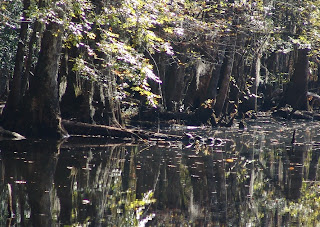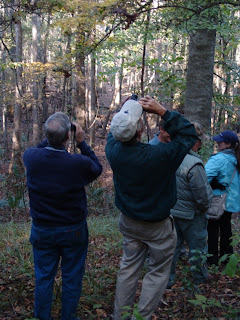Some of the U.S.’s Most Imperiled Birds Make their Home in South Carolina
New Report Identifies Species at Greatest Risk53 of the 178 birds that Audubon and the American Bird Conservancy (ABC) have identified as in need of top-priority conservation attention to ensure their continued survival spend at least part of their year in South Carolina. They have the dubious distinction of being included on
WatchList 2007, the newest and most scientifically sound list of America’s birds at greatest risk. Unlike those on Audubon’s recent survey of
Common Birds in Decline, these species are often rare and limited in range; consequently, they face a more imminent threat of extinction. For many of them, conservation efforts in South Carolina as well as nationally will play a critical role in determining their future health and survival.
The continental WatchList is based on a comprehensive analysis of population size and trends, distribution, and environmental threats, informed and improved by extensive scientific review. The 59 species on its “red list” are those of greatest concern, while the additional 119 merit their spots on the “yellow list” due to a combination of rarity and seriously declining numbers. Species found in either WatchList category demand immediate help while there is still time to save them.
South Carolina contains a diverse array of habitats, ranging from coastal salt marshes and sandy beaches to the bottomland hardwood swamps and black water rivers of the coastal plain to the cove hardwood forests of the mountains. More than fifty bird species found on WatchList 2007 utilize this diversity of habitats which are found across our state. Of the fifteen Red List species that are regularly found in South Carolina, nine occur only along the coast. The biggest threat facing many of these species is habitat loss and degradation. With more and more development, particularly along the coast, these birds will find less and less suitable habitat for breeding, feeding, and resting.
Some of the WatchList species found in South Carolina are well-known such as Swallow-tailed Kite, Black Skimmer, Red-headed Woodpecker, Wood Thrush, Prothonotary Warbler, and Painted Bunting, but many are birds you may have never heard of before such as Cory’s Shearwater, Black-capped Petrel, Swainson’s Warbler, Bachman’s Sparrow, and Saltmarsh Sharp-tailed Sparrow.
“Whether you have heard of these birds or not, all of them perform vital roles in sustaining South Carolina’s natural ecosystems. As citizens of South Carolina, we all have a responsibility to protect these vulnerable species. The time to act is now, while there is still time left,” said Jeff Mollenhauer, Director of Bird Conservation at
Audubon South Carolina.
“We must do more than just watch the birds we love at our feeders or in the disappearing forests and wetlands where they live, baring sad witness to their ever-falling numbers; we must all get involved in their conservation,” said Norman Brunswig, Audubon South Carolina Executive Director.
From the 53 WatchList species found in South Carolina we have selected the following five priority species: (images by Jeff Mollenhauer)
PIPING PLOVERThis small shorebird winters along the coastal beaches from North Carolina to Mexico. There are three separate breeding populations: the Atlantic and Great Plains populations, which are listed

as Threatened, and the Great Lakes population, which is listed as Endangered. Overall, there are only an estimated 6,400 Piping Plovers left in the entire world.
Threats: On the wintering grounds in South Carolina, their biggest threats are habitat loss and degradation and human disturbance, the latter especially from people walking their dogs off leash. Plovers and other shorebirds perceive dogs as predators, and every time they are flushed and forced to fly, they burn up critical energy needed to survive.
What you can do: If you see people walking their dogs off leash on the beach, please take a moment to inform them of the plight of the Piping Plover.
What Audubon SC is doing: We have been working with partner agencies on the South Carolina Shorebird Project, a program designed to increase our knowledge of the Piping Plover population in South Carolina and to help educate people about Piping Plovers and other shorebirds.
LEAST TERNThis species nests in large colonies on barrier islands along the east coast of the U.S and on sandbars in the rivers of the Mid-West. Due to loss of habitat many are now building nests on

the pebbled flat roofs of malls, schools, and other large buildings near the coast. In South Carolina, there are few remaining Least Tern nesting colonies in natural habitats and little is being done to protect tern chicks from the hazards of rooftop nesting.
Threats: Extreme high tides and human disturbance at nest colonies on barrier islands and beaches can cause destruction or abandonment of nests. With little management of the rooftop-nesting colonies, many chicks succumb to the hazards of rooftop nesting such as over-heating, falling off the roof, or getting stuck in drain pipes.
What you can do: Coastal residents can help by volunteering to protect a Least Tern rooftop-nesting colony in their area.
What Audubon SC is doing: We are developing a volunteer-based program to monitor and protect rooftop-nesting colonies.
WOOD THRUSH
Widespread throughout the eastern U.S., this species breeds in large tracts of mature deciduous forest in South Carolina. The melodious, flute-like song of the Wood Thrush reminds us that spring has once again returned. They are a neotropical migrant, meaning that they breed in the United States and Canada during the summer, but fly south for the winter to Mexico, the Caribbean, Central or South America. Wood Thrush populations in South Carolina have declined by more than 80% since 1966.
Threats: Deforestation and habitat fragmentation in both their breeding and wintering grounds.
What you can do: Cat-owners can keep their pets indoors, or only under their supervision when outdoors. The National Research Council reports that domestic cats are responsible for the demise of hundreds of millions of songbirds each and every year in the United States.
What Audubon SC is doing: We are working hard to protect the Wood Thrush and other neotropical migrants on its own sanctuaries and Important Bird Areas in our state, and on the wintering grounds by developing exchange programs with sanctuaries in Belize and Mexico.
PROTHONOTARY WARBLERProthonotary Warbler, the stunning yellow bird so typical of the swamps, rivers, and wetlands of the eastern U.S., has declined by more than 40% over the past 40 years. Like the Wood Thrush,

the Prothonotary Warbler is a neotropical migrant with wintering grounds as far south as the northern tip of South America.
Threats: Loss and degradation of wetlands both on their breeding and wintering grounds.
What you can do: Support Audubon and other conservation efforts to protect forested wetlands with your time and dollars.
What Audubon SC is doing: Our Francis Beidler Forest Center and Sanctuary near Harleyville is home to one of the highest breeding densities of Prothonotary Warblers in the entire state. During the spring of 2008, Audubon South Carolina will begin a citizen science project focused on Prothonotary Warbler to raise awareness of the species and increase public knowledge of its habitat needs at Beidler Forest and elsewhere.
BACHMAN’S SPARROW
This secretive sparrow breeds in longleaf pine savannas throughout the southeastern U.S. During the summer months, their distinctive song rings through the open piney woods. It is estimated that longleaf pine forest once covered as much as 90 million acres in the southeastern U.S.; now there are less than three million acres remaining. With little prime habitat remaining for the sparrow, its population has decreased by nearly 50% in South Carolina over the past 40 years.
Threats: Loss of longleaf pine savannas throughout the southeast.
What you can do: Support restoration of longleaf pine savannas.
What Audubon SC is doing: We are hard at work restoring and creating longleaf pine savannas on two of our major sanctuaries. The Silver Bluff Audubon Center and Sanctuary near Aiken contains 650 acres of recently restored and maturing longleaf pine savanna.
The new Audubon/ABC WatchList is based on the latest available data from the Christmas Bird Count and the annual Breeding Bird Survey along with other research and assessment from the bird conservation community. The data were analyzed and weighted according to methods developed through extensive peer review and revision, yielding an improved assessment of actual peril that can be used to determine bird conservation priorities and funding. Listed species may seem unfamiliar to many Americans. Unlike those on Audubon’s recent survey of Common Birds in Decline, these species are often rare and limited in range.
Contact: Audubon South Carolina
Name: Jeff Mollenhauer, Director of Bird Conservation
Phone: 843-462-2150
Email: jmollenhauer@audubon.org
 discovered many more alligator (Alligator mississippiensis) dens than we knew existed.
discovered many more alligator (Alligator mississippiensis) dens than we knew existed. 
 the logging access road. Obviously, a gator was within the water and active enough to stir up the sediment as the pool is not connected to any moving water. "During the dry season, and particularly during extended droughts, gator holes provide vital water for fish, insects, crustaceans, snakes, turtles, birds, and other animals in addition to the alligator itself." (USFWS)
the logging access road. Obviously, a gator was within the water and active enough to stir up the sediment as the pool is not connected to any moving water. "During the dry season, and particularly during extended droughts, gator holes provide vital water for fish, insects, crustaceans, snakes, turtles, birds, and other animals in addition to the alligator itself." (USFWS)



 the Prothonotary Warbler is a neotropical migrant with wintering grounds as far south as the northern tip of South America.
the Prothonotary Warbler is a neotropical migrant with wintering grounds as far south as the northern tip of South America. 





















 On Sunday, November 4,
On Sunday, November 4, 



 Jeff Mollenhauer, Director of Bird Conservation, has been a busy man this week! He reports on his bird's-eye view:
Jeff Mollenhauer, Director of Bird Conservation, has been a busy man this week! He reports on his bird's-eye view: